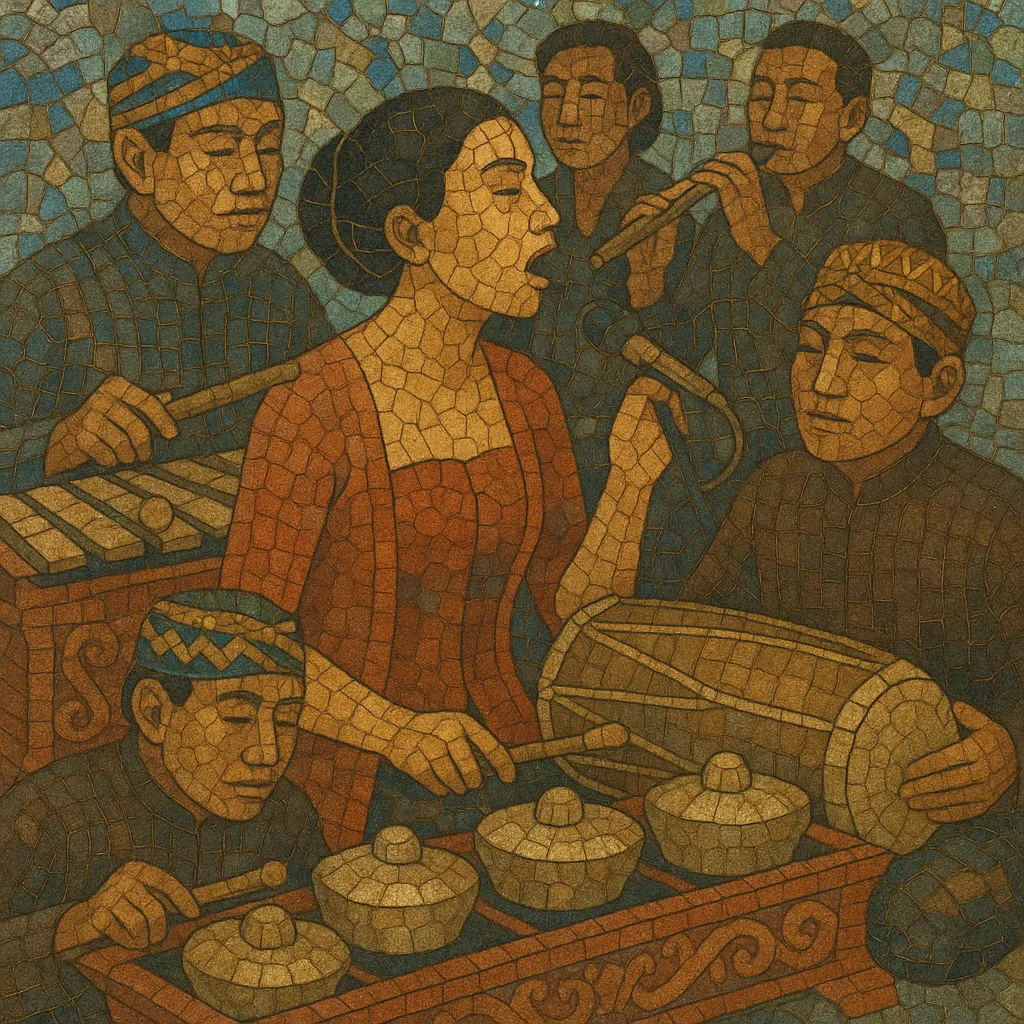Javanese gamelan is a sophisticated court-derived gong-chime ensemble tradition from Central Java, Indonesia. It features interlocking layers of melody organized by a colotomic (cycle-marking) structure, with the large gong ageng articulating the end of cycles and smaller gongs and drums shaping the inner form.
The music centers on a core melody (balungan) played by the saron family of metallophones, while elaborating instruments such as bonang, gender, gambang, rebab (bowed lute), and suling (bamboo flute) weave ornate patterns. A female soloist (sindhen) and a male chorus (gerong) often add vocal lines, and the kendhang (drum) leads tempo and transitions.
Distinctive tuning systems (laras) — slendro (approximately equidistant five-tone) and pelog (seven-tone with selected subsets) — and modal frameworks (pathet) give each performance its expressive color. Pieces unfold through density shifts (irama) and established formal types (lancaran, ladrang, ketawang, gendhing) that balance structure with performer-driven variation.
Javanese gamelan coalesced within the Hindu–Buddhist courts of Central Java and the surrounding indigenous gong traditions, reaching mature forms during the Islamic Mataram period (16th–17th centuries). Its instruments and tuning aesthetics reflect deep regional roots, while poetic and theatrical ties to wayang kulit (shadow theater) and classical dance embedded the music in ritual and courtly life.
In the courts of Yogyakarta and Surakarta, repertories, instrument sets, and formal structures were standardized. The dual tuning systems (slendro and pelog), pathet modal theory, and colotomic forms (lancaran, ladrang, ketawang, and long-form gendhing) were codified. Each palace maintained named gamelan sets with unique tunings, emphasizing that instruments are built as inseparable ensembles rather than interchangeable parts.
The 20th century saw flourishing pedagogy and documentation by court musicians and later ethnomusicologists. Radio and recordings expanded the audience, and conservatories in Surakarta (Solo) and Yogyakarta formalized training. Composers and dalang (puppeteers) created new gendhing and theatrical works, while vocal practice (sindhenan) and choral styles (gerongan) evolved alongside classic forms.
From the mid-20th century, Javanese gamelan ensembles were established in universities and cultural centers worldwide, inspiring Western composers and catalyzing American and Malay gamelan traditions. Contemporary Indonesian artists also experiment with electroacoustic media and intercultural collaboration, while court and village traditions continue to sustain ritual, dance, and theater contexts.
Select a laras (slendro or pelog) and an appropriate pathet (e.g., slendro nem/sanga/manyura; pelog lima/nem/barang). These determine characteristic tones, cadential (seleh) notes, and time-of-day/affective associations.
Decide on a form such as lancaran (short, lively), ketawang (16-beat elegance), ladrang (32-beat breadth), or a longer gendhing. Plan the colotomic structure: where the gong ageng, kempul, kenong, kethuk, and kempyang articulate cycles and subcycles.
Compose a concise balungan (core melody) that outlines seleh tones and aligns with gong points. Keep it singable and balanced; the inner logic of the balungan guides all elaborating parts.
Use kendhang patterns to cue tempo changes, transitions, and dance/theater cues. Shape texture through irama (density levels), letting elaborating instruments expand or contract their note density while the balungan remains proportionally steady.


